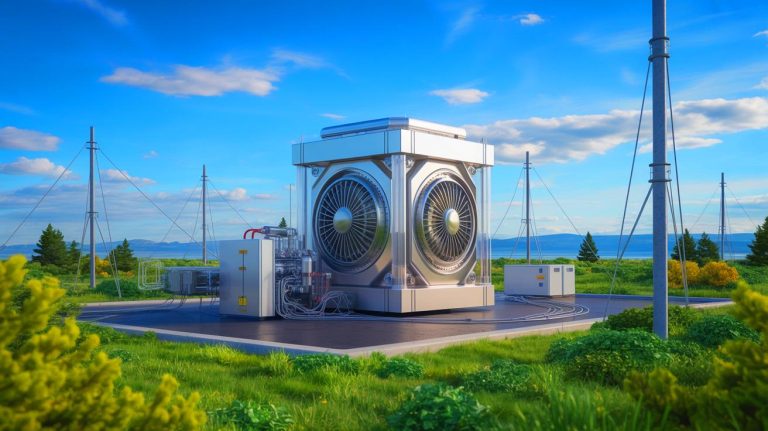| IN A NUTSHELL |
|
In an era where the demand for clean and sustainable energy is ever-increasing, innovative solutions are paramount. The Microreactor Application Research Validation and Evaluation (MARVEL) project is poised to revolutionize nuclear energy development in the United States. Managed by the Idaho National Laboratory (INL) for the Department of Energy (DOE), this groundbreaking initiative introduces an advanced test reactor that could pave the way for future microreactor technologies. As the first new reactor constructed at the INL site in over forty years, MARVEL stands as a beacon of progress and innovation in the realm of nuclear energy research.
The Role of MARVEL in Advancing Nuclear Energy
The MARVEL project is a significant leap forward in nuclear energy research and development. Designed as a sodium-potassium (NaK)–cooled test reactor, MARVEL serves as a physical test bed at INL’s Transient Reactor Test Facility (TREAT). Its primary goal is to facilitate integrated testing of nuclear reactor components, autonomous controls, microgrid interfaces, and process heat applications in a real nuclear environment. This initiative not only supports the DOE’s advanced microreactor research but also acts as a catalyst for private-sector nuclear energy development.
The compact core of MARVEL consists of 36 uranium hydride fuel rods, each containing five fuel meats enriched to 19.75% U-235. These rods are moderated by hydrogen and surrounded by a beryllium neutron reflector, leveraging existing technology and off-the-shelf components for expedited construction. The use of high-assay, low-enriched uranium from existing research materials ensures the project’s feasibility and efficiency. By providing a platform for testing and demonstrating advanced nuclear technologies, MARVEL is set to transform the landscape of nuclear energy research.
Phased Operation and Strategic Implementation
MARVEL’s operation is meticulously divided into three strategic phases over a two-year period. Currently in its first phase, the project focuses on finalizing design, acquiring environmental permits, fabricating components, and conducting safety preparations. This phase is expected to culminate in fuel loading and initial criticality at the TREAT facility by late 2027 or early 2028. The progression of these phases underscores the project’s commitment to rigorous testing and validation of nuclear technologies.
Upon completion of the first phase, MARVEL will transition into its second phase, which emphasizes testing power production systems and supporting industrial demonstrations under real operating conditions. This phase invites industrial end users to design and fabricate the equipment and processes they wish to demonstrate. Given the project’s short duration, potential stakeholders are encouraged to prepare in advance to maximize the opportunity for technological advancement. The final phase focuses on decommissioning activities, providing invaluable opportunities for post-irradiation examination and end-of-life research.
MARVEL as a Catalyst for Microreactor Development
INL positions MARVEL as a pivotal development tool for advancing microreactor technologies. The project aims to provide a comprehensive platform that the private sector can leverage to mature novel nuclear technologies and demonstrate innovative new use cases for microreactors. With an 85-kWth reactor capacity, MARVEL will produce over 10 kWe of electricity in its initial operational stage. As operations progress, the reactor will offer process heat above 572°F to end-users for demonstration purposes, showcasing its versatility and potential applications in various industries.
Since its establishment in 1949, INL has constructed 52 reactors, with MARVEL marking the first new build in over four decades. This milestone represents a new era in U.S. nuclear development, reflecting the nation’s commitment to pioneering sustainable and efficient energy solutions. By fostering innovation and collaboration between public and private sectors, MARVEL is set to drive significant advancements in nuclear technology.
Looking Ahead: The Future of Nuclear Innovation
As the MARVEL project progresses, its impact on the future of nuclear energy cannot be overstated. The DOE’s invitation to private-sector nuclear developers to participate in experiments and demonstrations at MARVEL underscores the project’s collaborative nature and its potential to catalyze groundbreaking advancements in microreactor technologies. By harnessing the capabilities of MARVEL, stakeholders can explore new frontiers in nuclear energy, paving the way for a more sustainable energy future.
The project’s success will hinge on the continuous engagement of industry leaders, researchers, and policymakers who share a common vision for innovative energy solutions. As we look to the future, one question remains: How will the advancements made possible by MARVEL reshape the global energy landscape and address the pressing challenges of our time?
Did you like it? 4.5/5 (28)








Wow, 50 years since the last one? That’s a long time! 😮
How safe is this new reactor, especially in remote areas?
What happens if something goes wrong in these remote locations?
This is cool, but where’s the solar love? 🌞
Finally, some innovation in nuclear energy! Thank you for sharing this. 😊
How does MARVEL compare to traditional nuclear reactors in terms of efficiency?
Thanks for the article! The future of energy looks promising.
Will there be any job opportunities in this field for recent grads?
Why haven’t we seen more of these microreactors sooner?
Is there any risk of nuclear proliferation with these small reactors?
Can’t wait to see how this impacts energy access in remote areas! 🚀
What about the waste? How is that handled?
Are there any environmental concerns with this project?
This is a game-changer for remote locations without grid access!
So, when can we expect the first electricity from MARVEL?
Does this mean lower electricity costs for consumers?
I’m skeptical. Nuclear energy always seems risky. 😬
How does this project align with the current renewable energy goals?
Hope we see more projects like this in other countries too.
Is this really the best way to achieve sustainable energy?
I’m excited to see how private companies will get involved!
Why is the U.S. only now building another reactor after 50 years?
What does this mean for the future of coal and gas?
Isn’t nuclear energy dangerous? Why take the risk?
Hope this actually leads to cleaner energy solutions. Fingers crossed! 🤞